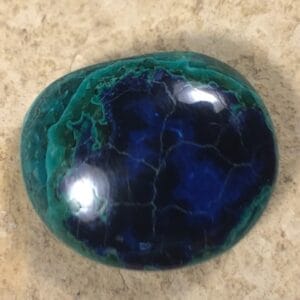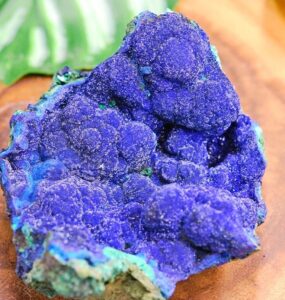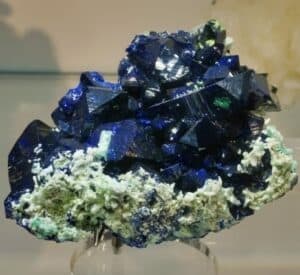Azurite may not be common or abundant, but it is well-known for its beautiful blue colors. Azurite’s characteristic deep blue to violet-blue hues are incredible and it can be found with its close cousin malachite.
Azurite’s hardness is only 3.5 to 4.0 on the hardness scale. While it is easy to cut and shape into cabochons, small carvings, ornaments, and beads, its softness limits its use in jewelry.

How to Identify Azurite Through Testing
There are various ways to identify rocks, minerals, crystals, and gemstones, but we will be using a method I learned while attending the Gemological Institute of America. If you’ve learned a unique way to identify gems, then feel free to share it with us.
Let’s take a deeper look into how to identify Azurite like a pro.
Visual Inspection
The visual inspection starts with what form of Azurite you have. The questions below are pretty easy to answer, but each type will have its own process for identifying them. Keep in mind it is fairly common to find malachite with azurite. As you can see from the examples below, malachite is present in most specimens and some cabochons.

Is it a cabochon? If you’re dealing with a cabochon, then it should have a low to medium polish with very little pitting on the surface. You’ll notice most cabochons have green banding mixed in with the royal blue color of azurite. This is common and the green color is malachite.
Is it faceted? There is a very slim chance you have a faceted piece of azurite because crystals are hard to come by and the material is soft which means it doesn’t hold up well in jewelry.

Is it a specimen? Azurite is found in different forms, and you’ll get better at identifying these forms by looking at and inspecting this mineral over time. Here’s a list of characteristics Azurite displays when it’s a specimen.
- Various shades of beautiful blue and bits of green undertones.
- You’ll be able to do the streak test. Keep reading below if you have a rough piece with no commercial value.
- Azurite has a natural shimmer and sparkle.

Is it tumbled? Azurite is fairly soft and doesn’t make for tumbling material. You can find them in free form cabochons but tumbled material is fairly uncommon.
Physical Properties of Azurite
Let’s take a look at the physical properties of Azurite. Knowing what to look for will help you more easily identify what you’re looking at.
Color: Azure Blue, Light Blue, Blue – Light blue in transmitted light
Clarity / Transparency: Transparent, Translucent
Luster: Vitreous
Cleavage: Perfect
Fracture: Conchoidal
The Streak Test
This is a destructive test, so you need to ensure that you’re allowed to damage the specimen or stone if you choose to use this method. Once you’ve developed robust knowledge in identifying rocks and minerals, you won’t be using destructive tests.
A mineral streak test involves scraping the stone against a harder surface to see what color remains. When dealing with Azurite, you’ll notice a light blue streak.
Raw Azurite can be streaked across a piece of white paper to expose its color; Azurite will always be light blue.
Tumbled specimens are tested by scraping a specimen across a piece of ungalvanized porcelain, typically known as a streak plate.
Magnet Test
Azurite is an extraordinary magnet that’s heavily influenced by quantum effects. Azurite forms a diamond chain arrangement of spins, and it’s been considered a contender as the first mineral to show spin-⅓ excitations. Spin-½ excitations are typically found in magnetic systems. A crucial understanding of Azurite’s magnetic behavior is the distinctive ⅓ magnetization phase, where ⅓ of the copper spins are polarized!
Hardness Test
I don’t recommend actively testing the hardness of a stone because it’s destructive in nature and doesn’t really provide a definite answer to what type of stone it is. That said, Azurite has a hardness of 3.5 to 4 on the Mohs hardness scale.
Refractive Index Test
Determining the refractive index, or RI as it’s referred to by gemologists, for Azurite is relatively straightforward, but you’ll need a specific piece of test equipment and the RI fluid to go with it. Before you place the stone on the refractometer, you want to make sure you have a flat, somewhat polished surface to take a reading.
Azurite’s Refractive Index: nα = 1.730 nβ = 1.758 nγ = 1.838
Each gemstone has its own RI, so discovering a sample’s RI can help you figure out what sort of stone it actually is.
Step 1 – Place a small bead of RI fluid on the metal surface of the refractometer near the back of the crystal hemicylinder (the window on which the stone will sit).
Step 2 – Place the stone facet face down on the fluid dot and slide it toward the middle of the hemicylinder crystal using your fingers.
Step 3 – Look through the viewer lens without magnification. Continue looking until you see the outline of a bubble, then look at the bottom of this bubble. Take the reading from there, rounding the decimal to the nearest hundredth.
From time to time, you’ll run into the issue of not having a flat surface to work with. In this instance, you’ll need to leave the top of the refractometer open and hold the rounded stone with your hand. Hopefully, you’ll be able to pull a reading off the gauge.
Birefringence Test
Consider testing the birefringence, as well. Birefringence is related to RI. While doing the birefringence test, you will turn the gemstone on the refractometer six times throughout the observation period and note the changes.
Perform a standard RI test. Instead of keeping the stone still, gradually turn it 180 degrees, making each separate turn about 30 degrees. At each 30-degree mark, take a new RI reading.
Subtract the lowest reading from the highest to find the stone’s birefringence. Round it to the nearest thousandth.
Birefringence: δ = 0.108
Single or Double Refraction
Azurite is doubly refracting or bi-refraction.
For this test to be accurate and beneficial, the stone needs to be transparent in nature. If the light won’t pass through the stone, then there is no way to test for single or double refraction.
Check for single or double refraction. Use this test on translucent and transparent stones. You can determine whether the stone is only singly refractive (SR) or doubly refractive (DR) to help identify it. Some stones can also be classified as aggregate (AGG).
Turn on the light of a polariscope and place the stone face down on the lower glass lens (polarizer). Look through the top lens (analyzer), turning the top lens until the area around the stone looks darkest. This is your starting point.
Turn the analyzer 360 degrees and watch how the light around the stone changes.
If the stone appears dark and stays dark, it is likely an SR. If the stone starts light and remains light, it is likely AGG. If the stone’s lightness or darkness changes, DR is likely.
Checking The Diaphaneity
Diaphaneity refers to the mineral’s ability to transmit light. For instance, some minerals are transparent or translucent. When they’re thick, a small amount of distortion might occur, but light will pass through them relatively freely.
Azurite is transparent to subtranslucent. However, its translucency depends on the form it has taken. If the Azurite has an earthy form, there won’t be much light traveling through it. Still, if it happens to take on a crystalline structure, you should expect an opaque diaphaneity.
Finding The Specific Gravity
Every stone has its unique specific gravity, which helps us identify them. Specific gravity is one of the best properties to measure when identifying mineral specimens. Most minerals have a narrow range of specific gravity, so getting an accurate measurement can go a long way toward identification.
Specific gravity is a unitless number describing how heavy a mineral is compared to equal volumes of water. For example, if a mineral is three times as dense as water, it’ll have a specific gravity of three. This is useful because while two minerals might be the same size, they’ll each have a different specific gravity.
The larger the sample, the more precise the readings tend to be. Remember that this technique can only be used for single mineral or crystal masses. It will not work for minerals embedded in host rocks.
Azurite’s Specific Gravity: 3.77
As helpful as specific gravity is for identifying minerals, amateurs are usually constrained by the lack of necessary tools for the job. However, one way to work around this is to hold the specimen and note how heavy or heft it feels compared to what you might expect a specimen of that size to weigh.
If you want to determine the specific gravity of your stone like a pro, then you’ll need to invest in a higher-end scale. This is the one gemologists use OHAUS Density Determination Kit.
Identifying Rocks and Minerals Like a Pro
Hopefully, you feel confident in your practice of identifying a piece of Azurite after reading and applying this guide. You’ll be using the visual part of this guide the most, and you’ll get better as you interact with more gemstones. Before you know it, you’ll be identifying stones like a gemologist.
If you run into any issues or get confused, then feel free to reach out, and I’ll do my best to assist you in the identification process.
- Identify Enstatite - March 12, 2024
- Identify Cerussite - March 3, 2024
- Identify Bytownite - February 18, 2024
